
Stuart has been filling up the photos database for months now with mouthwatering pictures of Hong Kong climbing. So for anyone who might be heading in that direction - or just wants to drool a bit - here's his take on the fun to be had.
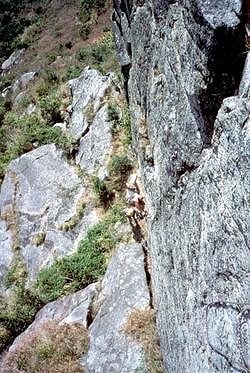
Lion Rock
Dominating the skyline beyond the Kowloon Peninsula, Lion Rock (so called because when viewed from certain angles the profile of the crag bears a striking resemblance to that of a lion) is probably the best crag to head to for those seeking routes with a bit of a mountain feel to them. Although not a huge crag, about 250ft, the granite cliff is perched high on a hillside well above the city and with few other parties generally climbing there it's easy to feel detached from the chaos of the crowds below.
Lion Rock was the scene of the first recorded attempts at rock climbing in Hong Kong, in fact, the first foray onto its walls in 1956 resulted in one fatality and a hasty retreat. The first climb was eventually established two years later by two British Army Officers and the resulting route, Wards Groove (F6a+), is now an established classic giving sustained wall and crack climbing up the west face of the crag. Following this ascent the crag remained largely dormant until the early 1990s when British expat Martin Lancaster began exploring its walls and equipping routes with bolts and abseil chains.
Nowadays the crags has upwards of 25 routes graded between F6a and F7c, nearly all of which are fully equipped (some a little excessively) and mostly on good solid rock. The crag has two distinct faces that get the sun at different time of the day making it ideal for either escaping the heat or topping up your tan, which ever takes your fancy. The west face is characterised by numerous cracks and grooves interspersed with steep walls whilst, in contrast, the east face gives a continuous sweep of vertical granite with few natural features.
Routes worth seeking out on the west wall include Gweilo (F5+), the Cantonese word used to refer to westerners, the literal translation of which means 'foreign devil'. This route picks and weaves an intricate line up slabs, cracks, corners and walls and all at a relatively amenable grade. For those seeking a more demanding ascent a combination of The Arete (F6a+), the brutally overhanging layback crack of Firecracker (F6c), and wall and arete of Scaredy Cat (F6c+) gives continuous and varied climbing.
In contrast to the approach required for success on routes on the west face, the routes on the east face tend to give more sustained technical climbing on steep walls. The easiest line up this face, and one of the best routes in Hong Kong, is Austrian Staircase (F6b). The first pitch of this route provides fine laybacking up a steep flake on generally large holds whilst the second pitch gives superb technical climbing up a series of cracks and grooves. Breaking out left from half way up pitch one and continuing directly up the steep wall above gives sustained crimpy wall climbing on Lion King (F6c) and the recently added Tigger (F7a) gives two fine technical pitches straight up the middle of the face. [Editor's note: since he put it up, he should know!]
Tung Lung Chau
Located just to the east of Hong Kong harbour, the small island of Tung Lung contains probably the highest concentration of quality sport climbs in Hong Kong. The most popular crag on the island, Technical Wall, is a 60ft high volcanic sea cliff with a huge platform conveniently located at its toe. The right handside of the wall composes of steep slabby routes with grades generally in the region of F5+. To the left of the slabs the wall becomes steeper with several overhangs high on the wall. Two routes in this area definitely worth seeking out are Small Roof (F6a+), which gives excellent enjoyable climbing up a crack and groove followed by some tricky moves through an overhang and Big Hand (F6a) which weaves a sneaky line through the roofs to the left of this. Further left again the crag really steepens up and gives generally sustained gently overhanging routes. The best of these routes are the ultra classic The Corner (F7a), a superb exercise in technical bridging and laybacking, Dimple Face (F7b+), a very sustained proposition up one of the steepest bits of the crag, and Tung Lung Bad Boy (F7c+). Be warned, this crag gets extremely busy on Sundays and public holidays and is probably best avoided in favour of seclusion elsewhere.

The Sea Gully, located about five minutes' walk from Technical Wall, gives a very different style of climbing. Here the routes tend to be up near vertical compact walls that often appear featureless and improbable until you actually get on them. Although only a single pitch, most routes start off a ledge on the right hand side of the gully about 40ft above its floor, which adds a certain sense of exposure to the overall atmosphere of climbing there. The End of the World (F6b+), located at the mouth of the gully is probably the best place to experience this with the floor dropping away from your feet the minute you step onto the route. For those not seeking too much exposure several routes exist at the entrance to the gully the best of which have to be Green Slab (F6a) a delightful technical slab climb, and Chime of Dog (F7a) which has just about every conceivable type of climbing on it.
Just around the corner from Sea Gully lies the appropriately named Big Wall, a 180ft face rising directly out of the sea. Local activist Daniel Ng (who is also responsible for most of the other routes on Tung Lung) only recently developed the wall and, as yet, most of the routes remain unnamed. However, 15 routes, between two and three pitches long and F6a and F7b provide some exciting sport climbs in a stunning situation. It's worth seeking local advice on how to access the wall and which routes go where as no guide is readily available.
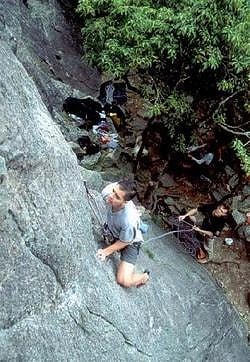
Beacon Hill
Located on the hillside just to the east of Lion Rock, Beacon Hill (Pat Ka Shan) offers easily accessible routes on top quality granite. The types of climbs are extremely varied from relatively easy corner cracks, delicate friction slabs to steep sustained walls. Routes worth seeking out include King Cobra (F4), a relatively easy, but none the less fine, crack and corner climb, which is also the only route on the crag requiring natural gear, Pretty Girl (F6a) a superb exercise in delicate slab climbing, Angels Wing (F6b+), an awkward, but satisfying, wall climb, and Lizard (F7a+), an excellent line up a gently overhanging face.
Bouldering
Hong Kong's hillsides are literally scattered with thousands of boulders, but tend to be fairly densely vegetated. Numerous trips out with machetes in hand have been made by local climbers over the years in order to seek out and develop some of these. Probably the most significant of these discoveries were three groups of boulders located high on a hillside over looking Tsuen Wan in the New Territories. A dedicated effort is required for climbing here as the boulders are only accessible via a harsh 30 minute uphill slog. However, the effort is well worth it as you are rewarded with quality problems up slabs, aretes, grooves and walls on pristine pocketed volcanic boulders. The grades of the established problems vary between 4a and 6c (UK tech grade) in difficulty and most problems are marked, Fontainebleau style, with a number painted at their base.
Other areas
The crags previously mentioned are the ones with the easiest access, all can be reached by public transport and walking, and the highest concentration of quality routes. Numerous other crags are dotted all over Hong Kong and, given time, are well worth seeking out. Particularly nice ones include Shek O, Kowloon Peak, Temple Crag and the sea cliffs at Clear Water Bay.
Although by no means a climbing holiday destination in its own right, Hong Kong does provide a useful 'stop over' point for trips to numerous other locations. So next time you head out this way, take a few extra days and go explore, you won't be disappointed.
Practicalities
Locations
Details of nearly all the crags described can be found on the website www.hongkongclimbing.com. The current guidebook to the area Rock Climbing in Hong Kong by Cicerone Press is quite out of date but has reasonably good descriptions of how to find crags.
| Lion Rock | Take the MTR (Mass Transit Railway) to Lok Fu station. From there take a taxi to Lion Rock Country Park (Sz Tsz San). A footpath, with signposts, leads up the hill towards the crag. When approximately level with the toe of the crag a small dirt path breaks off right from the main track (by a Danger - Steep Cliff sign) and leads to the foot of the cliff. Approach time approx. 45 minutes. |
| Tung Lung Chau | The only way to access Tung Lung Chau is via boat. Ferries run from the typhoon shelter at Sai Wan Ho at the weekends. They leave at 9am and 10.30am on Saturdays and 9.30am and 11am on Sundays and cost HK$28 return. No ferry service is available on weekdays and the only way of accessing the island is to hire a Sampan, small wooden boats, from the same location. The cost of this is considerably higher, approx. HK$300 for the round trip. From the ferry pier follow the concrete footpath towards Tung Lung Fort (signposted). The crags are located just beyond the fort. Free topo's for both Technical Wall and Sea Gully are available from the noodle shop passed on the way to the crag. |
| Beacon Hill | Take the MTR to Shep Kip Mei station. From there take a taxi towards Pat Ka Shan. An access road for a WSD Service reservoir breaks off Lung Chung Rd north east of Tai Wo Ping. Get the driver to take you as far as possible up the access road, to a small covered service reservoir. A small footpath leads up the hill to the right of the reservoir and the crag is about 10 minutes walk away. A topo showing all routes at the crag is fixed on a wooden board at the foot of the cliff. |
| Tsuen Wan Boulders | These are very difficult to locate without the aid of a map. A detailed description of their location can be found on the website http://hongkongclimbing.bizland.com. The boulders are located on the hillside north of Tsuen King Circuit, Tsuen Wan. A concrete footpath leads up the hill from opposite the T.L. Adventist Hospital, which can be reached either by taxi or bus (Number 39, Allway Gardens) from Tsuen Wan MTR station. Follow this up and over a catchwater. Having passed the catchwater, continue up the hill and take the first available right hand turn. Continue almost to the crest of the hill, where the path makes an abrupt turn to the left, a small dirt track leads off right to a collection of boulders, Ha Fa Shan, with a red and white trig point on top of one of them. To reach the other sets of boulders, Shek Lung Kung and Lin Fa Shan, continue along the concrete path where it turns left for another 20 minutes or so, the boulders are located close to the path and are relatively obvious. |
General Details
For general info on Hong Kong, where to stay, eat, sights to see etc. its best to consult a guidebook to the area. These will also give pointers on how to spend your time when not climbing.
Where is it?
Have a look at this map from Mapquest for a general overview of Hong Kong's layout.
To see where it lies generally in Asia, see this page from Mapquest. Hong Kong is the tiny lump north of the Philippines, south-east of China.
Climate
Undoubtedly the best time of year to visit Hong Kong is between November and February when the region is generally blessed with clear blue skies, relatively warm temperatures and low humidity. Try to avoid visiting between April and September when the weather is unsettled, hot, humid and the odd Typhoon likes to make its way by.
What gear to Bring
Nearly all of the climbs in Hong Kong are bolt protected so a single 50m rope and rack of 10-15 quick draws will suffice.
Climbing Shops
Three dedicated climbing shops are located within Hong Kong. The best of these, Chamonix Alpine Equipment, is located on Shanghai Street in Yau Ma Tei, which has reasonable prices and most items kept in stock. The Hong Kong Mountain Training Centre shop, located on Fa Yuen Street in Mongkok and operated by the same people as Chamonix, is also worth checking out for good deals. Mountain Services Ltd, located on Des Voeux Road in Sheung Wan stocks a limited amount of climbing equipment and is generally more expensive than the other shops.
Climbing Walls
There are several climbing walls in Hong Kong, mostly located within Kowloon. Unfortunately many of these are operated by the Leisure and Cultural Services Department and are tied up in the local bureaucracy so will be inaccessible to the passer through. Access to these walls, located at the games halls at Shep Kip Mei and Shun Lee Tsuen, can only be gained following an assessment course organised by the Hong Kong Mountaineering Union (HKMU), who can be contacted at 2504 8124. The walls that will be of most use are operated by the YMCA and located at the Salisbury Hotel, Tsim Sha Tsui, which consists of two converted squash courts, and at King s Park, Jordan, an 18m outdoor leading wall. Both of these walls require a simple assessment to be taken prior to using them. A small bouldering wall is also located above the Hong Kong Mountain Training Centre shop in Mongkok and an excellent new bouldering wall, Climber Land, has just opened at 22-28 Kennedy Street, Wanchai.





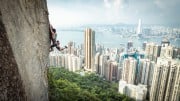


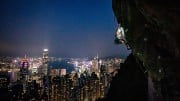
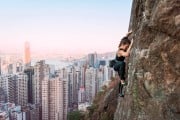
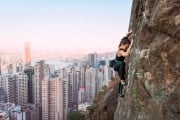



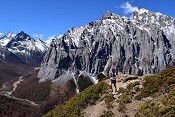


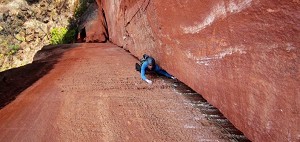




Comments